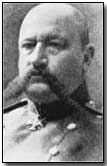Primary Documents - Nikolai Yudenich on the Russian Capture of Erzerum, 16 February 1916
 Reproduced below is the
text of Nikolai
Yudenich's report on the Russian capture of Erzerum from Turkish control
on 16 February 1916.
Reproduced below is the
text of Nikolai
Yudenich's report on the Russian capture of Erzerum from Turkish control
on 16 February 1916.
Yudenich was perhaps Russia's most successful wartime field commander, winning victory after victory against Turk forces.
Click here to read the official British military observer's report of the fall of Erzerum, written by Morgan Price.
The Russian Capture of Erzerum, 16 February 1916 by General Nikolai Yudenich
The fortress of Erzerum was the only fortified point in the interior of Asia Minor, protecting Western Armenia and Anatolia and commanding all the best roads of Transcaucasia and the interior of Asia Minor.
For many years past great improvements had been carried out in the works by the Turks, with the assistance of the Germans.
The terrain in front rendered it naturally strong, while it was covered on the flanks by mountain masses most difficult of approach and with their passes protected by powerful forts.
Such was the formidable barrier on the path of our offensive, with enormous defensive advantages on the northeast and east. During the five days' assault the fortress was defended by the Turks with a stubbornness to which the enormous quantity of killed and frozen corpses gives testimony.
The Caucasus army succeeded in surmounting steep mountains protected not only by frost but by wire entanglements and other defences, and assaulted the fortress after an artillery preparation.
The assault on the forts and the principal position lasted from February 11th till February 15th inclusive. After we had taken the forts on the left flank of the principal Turkish line of defence, extending about 27 miles, the fate of the forts in the centre and on the right flank, and, after them of the second line forts and the principal defensive position, was decided on February 16th after short attacks.
These fortifications, which, were full of Turkish dead, remained in our possession.
During the assault on the fortress several Turkish regiments were annihilated or made prisoners with all their officers. On the line of forts alone we took 197 pieces of artillery of various calibres in good condition. In the defence works of the central fortress we took another 126 pieces of artillery. In the fortified region of Erzerum we took a large number of depots of various kinds, which have already been mentioned by the Headquarters Staff.
The exact number of Turkish prisoners is 235 officers and 12,753 men.
It is possible to estimate the force of the blow which we dealt the Turkish army, whose demoralized remnants are now withdrawing in disorder towards the west, if only by the fact that some Army Corps of three divisions now only number from 3,000 to 5,000 men with a few guns. All the remainder have either fallen into our hands or perished in the fighting, or from the cold.
According to latest information received, Turkish officer and soldier prisoners, who were captured in the fortified district of Erzerum and in the course of the pursuit, complain bitterly that their Headquarters Staff was concentrated in the hands of Germans.
The latter during the assault on the fortress of Erzerum were the first to abandon the fortified positions, causing a panic and disorder among the already shaken Turkish troops.
The great Russian advance west of Erzerum came to an end only with the exhaustion of the pursuers. In the south, Mush, eighty miles beyond Erzerum, fell on February 19th; and on March 1st the Russians were at Kamak, only seven miles northeast of Bitlis.
On the following day Bitlis itself was taken, the mountain pass opening up the whole of the Tigris valley, and only 100 miles from the Turkish railhead at Nisibir, thus coming into the possession of the victorious invaders.
Here again the Russians found themselves confronted with terrible obstacles owing to continual snowstorms and severe frost at an altitude of nearly 5,000 feet.
Bitlis had been an important Armenian centre, but there were few of the oppressed race left to welcome their liberators, the Turks and Kurds, under Djevdet Pasha, having massacred some 15,000 of them in the previous June.
With this success the whole of the Van region passed into Russian hands, and the connection between the Turks in Anatolia and their forces across the Persian frontier and south of Lake Urmia was severed.
Source: Source Records of the Great War, Vol. IV, ed. Charles F. Horne, National Alumni 1923
Panzer was a term used to describe a German tank.
- Did you know?
